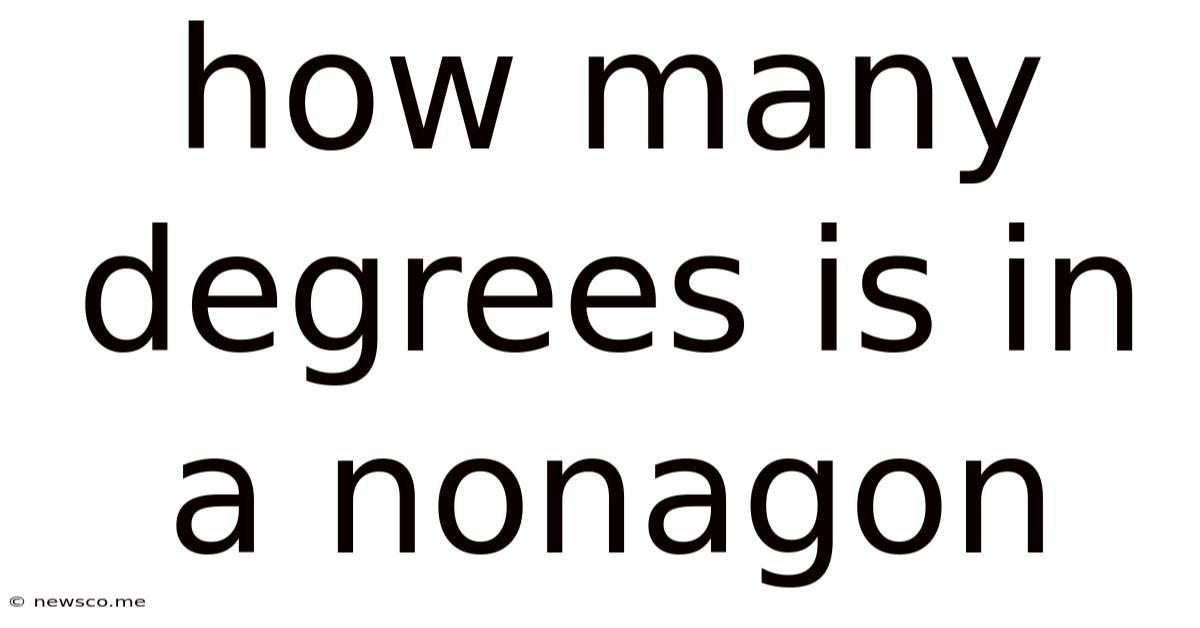How Many Degrees Is In A Nonagon
News Co
May 08, 2025 · 4 min read

Table of Contents
How Many Degrees Are in a Nonagon? A Deep Dive into Polygon Angles
The question, "How many degrees are in a nonagon?" might seem simple at first glance. However, understanding the answer requires delving into the fascinating world of geometry, specifically polygon angles and their properties. This comprehensive guide will not only answer the question directly but also explore the underlying concepts, providing you with a robust understanding of polygons and their angles. We'll cover various methods for calculating the total degrees, explore related concepts like interior and exterior angles, and even delve into some advanced applications.
Understanding Polygons: A Foundation for Nonagon Angles
Before we tackle the nonagon, let's establish a solid foundation in polygon basics. A polygon is a closed two-dimensional figure with straight sides. Polygons are categorized by the number of sides they possess:
- Triangle: 3 sides
- Quadrilateral: 4 sides (squares, rectangles, parallelograms, etc.)
- Pentagon: 5 sides
- Hexagon: 6 sides
- Heptagon (or Septagon): 7 sides
- Octagon: 8 sides
- Nonagon: 9 sides
- Decagon: 10 sides
- And so on...
Each polygon possesses specific properties regarding its angles, which are crucial for many mathematical and practical applications.
Calculating the Interior Angles of a Nonagon
A nonagon, with its nine sides, presents a specific challenge in angle calculation. The total number of degrees in the interior angles of any polygon can be determined using a simple formula:
Formula: (n - 2) * 180°
Where 'n' represents the number of sides of the polygon.
For a nonagon (n = 9), the calculation is as follows:
(9 - 2) * 180° = 7 * 180° = 1260°
Therefore, the total sum of the interior angles in a nonagon is 1260 degrees.
Understanding the Formula: A Geometrical Perspective
The formula (n - 2) * 180° is derived from the fact that any polygon can be divided into triangles. Imagine drawing lines from a single vertex of the nonagon to each of the other non-adjacent vertices. This divides the nonagon into seven triangles. Since each triangle has 180°, the total sum of the angles in all seven triangles equals 7 * 180° = 1260°. This method visually demonstrates why the formula works.
Regular vs. Irregular Nonagons: A Crucial Distinction
It's vital to understand the distinction between regular and irregular nonagons:
-
Regular Nonagon: All sides are equal in length, and all interior angles are equal in measure. In a regular nonagon, each interior angle measures 1260° / 9 = 140°.
-
Irregular Nonagon: Sides and angles are of varying lengths and measures. While the total sum of interior angles remains 1260°, the individual angle measurements will differ. To determine the individual angles in an irregular nonagon, you would need additional information, such as the measurements of other angles or sides.
Calculating Exterior Angles of a Nonagon
Exterior angles are formed by extending one side of a polygon and measuring the angle between the extension and the adjacent side. An interesting property of exterior angles is that their sum always equals 360°, regardless of the number of sides the polygon has.
Therefore, the sum of the exterior angles of a nonagon is 360°. In a regular nonagon, each exterior angle would measure 360° / 9 = 40°. Note that each interior angle and its corresponding exterior angle are supplementary (they add up to 180°).
Applications of Nonagon Geometry: Real-World Examples
While nonagons might not be as commonly encountered as triangles or squares, they do have practical applications in various fields:
-
Architecture and Design: Nonagonal shapes can be aesthetically pleasing and functional in building designs, offering unique architectural possibilities.
-
Engineering: Certain engineering structures might incorporate nonagonal components for strength and stability.
-
Tessellations: Although not as easily tessellated as some other shapes, nonagons can be incorporated into complex tiling patterns.
-
Game Design and Computer Graphics: Nonagons can add visual complexity and variety to game environments and computer-generated imagery.
Advanced Concepts and Further Exploration
For those interested in delving deeper, here are some advanced topics related to nonagon angles and polygon geometry:
-
Concave Polygons: These polygons have at least one interior angle greater than 180°. The formula for interior angles still applies, but the visualization becomes more complex.
-
Spherical Geometry: When polygons are drawn on a sphere (like on the surface of Earth), the rules for angle calculations change, leading to different results.
-
Non-Euclidean Geometry: This area of mathematics explores geometries where Euclid's postulates don't hold true, leading to alternative ways of understanding shapes and angles.
Conclusion: Mastering Nonagon Angles and Beyond
Understanding how many degrees are in a nonagon (1260°) is just the starting point. This exploration has provided a comprehensive overview of polygon angles, their calculations, and real-world applications. By mastering these fundamental concepts, you'll be equipped to tackle more complex geometrical problems and appreciate the elegant mathematical relationships underlying the shapes that surround us. Remember the key formula (n - 2) * 180° and the crucial distinction between regular and irregular polygons, and you'll be well on your way to becoming a geometry expert. The world of polygons is vast and fascinating – continue exploring!
Latest Posts
Related Post
Thank you for visiting our website which covers about How Many Degrees Is In A Nonagon . We hope the information provided has been useful to you. Feel free to contact us if you have any questions or need further assistance. See you next time and don't miss to bookmark.